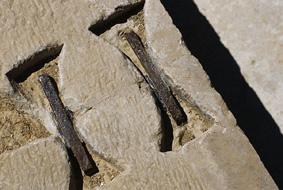Staple (fastener)
Staple (fastener) is a type of mechanical fastener used to join or bind materials together. Staples are made from wire and are driven into the materials being joined by a stapler or staple gun, a mechanical device designed for this purpose. The use of staples is widespread, encompassing applications in office supplies, construction, upholstery, and surgical procedures, among others.
Types of Staples[edit | edit source]
Staples come in various shapes and sizes, tailored to specific tasks or materials. The most common types include:
- Office Staples: Used in paper documents or for securing thin materials. These staples are typically used with a desktop stapler and are the most recognized form of staples.
- Heavy-Duty Staples: Larger and stronger than office staples, heavy-duty staples are used in construction and upholstery. They require a more powerful stapler or staple gun.
- Surgical Staples: Used in medical procedures to close wounds or incisions. Surgical staples are made from medical-grade materials and are designed to be biocompatible.
- Box and Packaging Staples: Designed for sealing cardboard boxes and other packaging materials. These staples ensure the secure shipment of goods.
History[edit | edit source]
The history of the staple dates back to the 19th century when the first patent for a stapler was granted. The invention of the stapler and staple revolutionized the way documents were collated, leading to widespread adoption in offices around the world. Over time, the design and functionality of staples and staplers have evolved, leading to the development of specialized staples for various applications.
Installation and Removal[edit | edit source]
The installation of staples is typically performed with a stapler or staple gun, which aligns the staple over the material and drives it through, folding the ends to secure the materials together. Removal of staples is done with a staple remover, a tool designed to safely and efficiently extract staples without damaging the materials.
Applications[edit | edit source]
Staples are used in a wide range of applications, from everyday office tasks to more specialized uses such as:
- Securing fabric to furniture in upholstery
- Fastening roofing materials in construction
- Binding pages together in bookbinding
- Closing wounds in surgical procedures
Environmental Considerations[edit | edit source]
The environmental impact of staples is a concern, particularly in terms of waste and the use of metals. Efforts to mitigate these impacts include recycling programs and the development of staples made from more sustainable materials.
See Also[edit | edit source]
| This article is a stub. You can help WikiMD by registering to expand it. |
Search WikiMD
Ad.Tired of being Overweight? Try W8MD's physician weight loss program.
Semaglutide (Ozempic / Wegovy and Tirzepatide (Mounjaro / Zepbound) available.
Advertise on WikiMD
|
WikiMD's Wellness Encyclopedia |
| Let Food Be Thy Medicine Medicine Thy Food - Hippocrates |
Translate this page: - East Asian
中文,
日本,
한국어,
South Asian
हिन्दी,
தமிழ்,
తెలుగు,
Urdu,
ಕನ್ನಡ,
Southeast Asian
Indonesian,
Vietnamese,
Thai,
မြန်မာဘာသာ,
বাংলা
European
español,
Deutsch,
français,
Greek,
português do Brasil,
polski,
română,
русский,
Nederlands,
norsk,
svenska,
suomi,
Italian
Middle Eastern & African
عربى,
Turkish,
Persian,
Hebrew,
Afrikaans,
isiZulu,
Kiswahili,
Other
Bulgarian,
Hungarian,
Czech,
Swedish,
മലയാളം,
मराठी,
ਪੰਜਾਬੀ,
ગુજરાતી,
Portuguese,
Ukrainian
Medical Disclaimer: WikiMD is not a substitute for professional medical advice. The information on WikiMD is provided as an information resource only, may be incorrect, outdated or misleading, and is not to be used or relied on for any diagnostic or treatment purposes. Please consult your health care provider before making any healthcare decisions or for guidance about a specific medical condition. WikiMD expressly disclaims responsibility, and shall have no liability, for any damages, loss, injury, or liability whatsoever suffered as a result of your reliance on the information contained in this site. By visiting this site you agree to the foregoing terms and conditions, which may from time to time be changed or supplemented by WikiMD. If you do not agree to the foregoing terms and conditions, you should not enter or use this site. See full disclaimer.
Credits:Most images are courtesy of Wikimedia commons, and templates, categories Wikipedia, licensed under CC BY SA or similar.
Contributors: Prab R. Tumpati, MD






